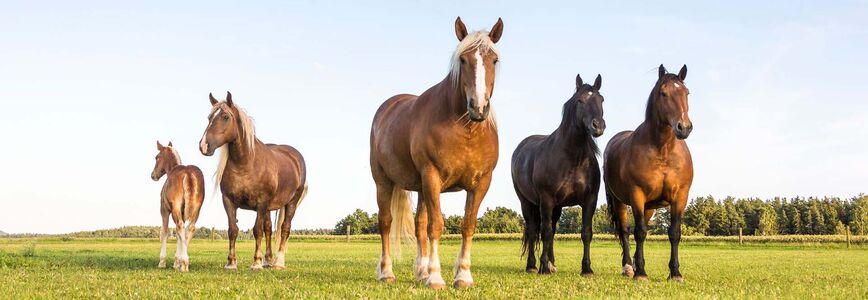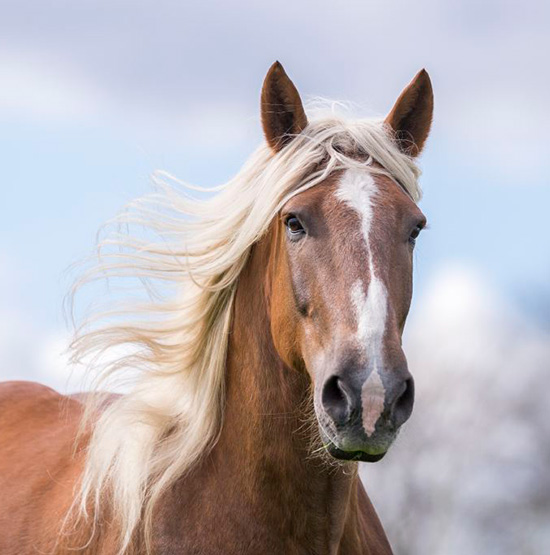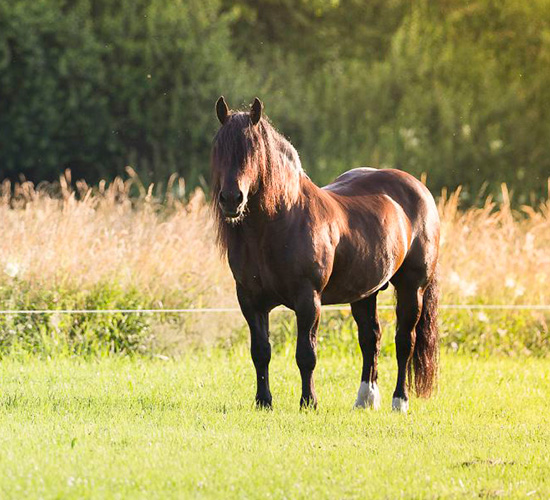
South German Coldbloods have a heavy physique and a gentle nature. In agriculture, they are used as draught horses, for example to transport wood.
Breed:
South German Coldblood
Group:
cold-blooded horses
Height at the withers:
160 - 165 cm
Appearance:
very muscular yet harmonious physique, medium-weight head on a medium-sized neck, expressive eyes, wide and deep chest, dry and clear-cut limbs.
Colour of coat:
predominantly chestnut-coloured and brown, but also black and leopard complex
Character:
friendly, lively, powerful, enduring, uncomplicated, attentive
Gait:
expansive, rhythmic, energetic
Origin:
Austria, Bavaria
Prevalence:
Southern Germany, Austria
Suited for:
recreational riding, dressage, hippotherapy, carriage driving, agriculture
Did you know? In the past, cold-blooded horses were used as working horses. Today they have been replaced by machines almost everywhere. Therefore, many cold-blooded breeds are threatened by extinction. Special breeding programmes are created to preserve the breeds. Germany’s biggest exclusive breeding for cold-blooded horses is located in Bavaria: with 115 stallions and almost 2,000 mares.

South German Coldbloods are closely related to Noriker horses.
South German Coldbloods developed from the Noriker horse breed, a very old breed that originates from the Roman province of Noricum. Noricum extended across a region within today’s Austria, Slovenia and Bavaria. Noriker horses were used as sure-footed working horses and the breed quickly populated the Alpine region –where the horses are still bred today. In the Southern German region, they were referred to as South German Coldblood starting in the mid-20th century and an independent breeding line with its own desired breed was developed. Other breeds were also included in the line. Still, Noriker horses and South German Coldbloods are closely related and very similar. However, in general, South German Coldbloods are slightly slimmer and larger than Noriker horses. Their temperament is also different. To breeders of both horses, distinguishing between the breeds is very important – as is continuing their line of breeding. Therefore, these two cold-blooded horse breeds are probably threatened by extinction the least.

South German Coldbloods are powerful and enduring.
Since South German Coldbloods are increasingly used as recreational horses rather than working horses, more and more emphasis was placed on agility and elegance while breeding. Although the horses are muscular and have a wide, deep chest, the neck should not be too short. Their head is of medium weight, and they have large and expressive eyes. South German Coldbloods also have dark and particularly hard hooves. Their most common colours are brown and chestnut with light-coloured long hair. Rarely there are also black, white and leopard complex horses. Their calm nature makes these horses ideal companions. They always keep their calm, and they are highly eager to work. They are concentrated and attentive when riding. Despite their liveliness, South German Coldbloods are very easy to lead. They are eager to learn, pleasant-natured and uncomplicated to keep. Training these cold-blooded horses as working horses is not very common these days. But their strength and endurance has been preserved. After all, in Bavaria, a federal state that loves traditions, they are often used to pull parade floats. Also, South German Coldbloods are popular recreational horses because they are not only versatile, they are also lively and good-natured horses. And due to their calm nature typical for cold-blooded horses and their patience, they are also ideal therapy horses.